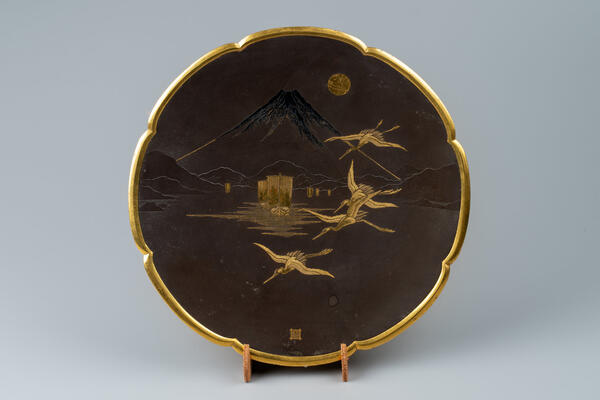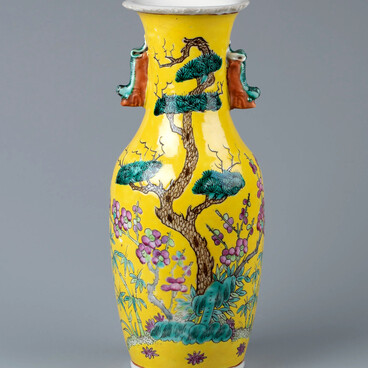The Samara Regional Art Museum presents a decorative plate with a traditional view of Mount Fuji and flying cranes. This is a bright example of Japanese artistic metalworking. Gold images of the sacred Mount Fujiyama, a boat floating on the water at its foot and cranes in the foreground vividly stand out against the black matte background.
Techniques such as damascening, nielloing and gilding were used to create the design. Damascening is an ancient technique for decorating steel and bronze items with precious metals — household items, weapons and military equipment: swords, daggers, shields, helmets, and later firearms. For damascening, recesses are made on the surface of the base metal in such a way that a softer metal can be embedded and forged into them. The decorative effect of damascening consists in the contrast in the color of the base and of the forged metal. They form a single surface on the finished product, and it seems as if the image of non-ferrous metal is painted on the base metal. First, the pattern is drawn on a piece of paper that has the same dimensions as the item. Then the design is transferred to the surface of the base metal. Damascening was used to create the image of the cranes on the plate.
In many countries, the crane is a symbol of good luck, devotion, and mindfulness. The Japanese culture is no exception. For the Japanese, the red-crowned crane symbolizes prosperity and longevity, happiness and love.
The main idea of the Japanese landscape lies in the very term for the genre: the Japanese word “sansui” literally translates as “mountains and waters”. It does not imply an exact depiction of beautiful scenery, but instead entails creating an image of ideal cosmic order. Mountains and waters are a representation of opposites that make up the driving force of the universe. Masculine and feminine, light and dark (everything that forms a pair of yin and yang) are opposites that endlessly generate each other and are present in each other; they form the harmony of the universe, the reflection of which is the main task of the artist.
Techniques such as damascening, nielloing and gilding were used to create the design. Damascening is an ancient technique for decorating steel and bronze items with precious metals — household items, weapons and military equipment: swords, daggers, shields, helmets, and later firearms. For damascening, recesses are made on the surface of the base metal in such a way that a softer metal can be embedded and forged into them. The decorative effect of damascening consists in the contrast in the color of the base and of the forged metal. They form a single surface on the finished product, and it seems as if the image of non-ferrous metal is painted on the base metal. First, the pattern is drawn on a piece of paper that has the same dimensions as the item. Then the design is transferred to the surface of the base metal. Damascening was used to create the image of the cranes on the plate.
In many countries, the crane is a symbol of good luck, devotion, and mindfulness. The Japanese culture is no exception. For the Japanese, the red-crowned crane symbolizes prosperity and longevity, happiness and love.
The main idea of the Japanese landscape lies in the very term for the genre: the Japanese word “sansui” literally translates as “mountains and waters”. It does not imply an exact depiction of beautiful scenery, but instead entails creating an image of ideal cosmic order. Mountains and waters are a representation of opposites that make up the driving force of the universe. Masculine and feminine, light and dark (everything that forms a pair of yin and yang) are opposites that endlessly generate each other and are present in each other; they form the harmony of the universe, the reflection of which is the main task of the artist.



